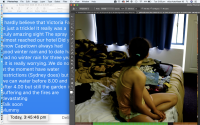
Image courtesy Eliza Hutchison
Q&A with Eliza Hutchison
9.4.20
Eliza Hutchison's work can be placed firmly within our cultural present. Her practice explores how truth and meaning can be manipulated and hybridised, feeding and shaping our understanding of mass culture and identity. Eliza has been commissioned to create a new body of work for PHOTO 2021 International Festival of Photography as the inaugural Photographer in Residence at the Parliament of Victoria. This conversation was conducted while social distancing, and delves deeper into Eliza's transition from sculpture to photography, how her practice has evolved over time and her continued fascination with The Truth.
Why did you want to be an artist?
I think fundamentally it was an interest in aesthetics and ideas. I started studying science at university, but became more and more fixated on the nature of my drawings of cells than the subject of science itself.
How has your practice changed over time?
I originally studied sculpture and photography as complimentary practice, in accordance with the art school structures of the time. When I started to exhibit, video works started creeping into my practice not as a conscious decision, but I was naturally drawn to the freedom and immediacy of the filmic medium. My video work was intrinsically documentation of performances. This flowed from my interest in the documentary medium and its filmmakers, particularly the work of Fredrick Wisemen. As my aesthetic developed, my work became less theatrical and more reductive. I began really exploring the materiality of the medium of photography itself. I think both my science and sculpture background really informed the way I thought about photography.
Also, after having children I found the singularity of the photographic image (as opposed to the filmic) more appealing. It’s potentially a more reductive process where I was not reliant on others to help me explore ideas. My work in turn became overtly biographical, but in a very sideward sort of way, as the biographical was essentially reflective of the larger social contexts.
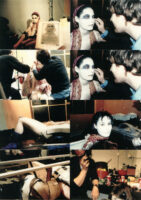
Eliza Hutchison, Memphis Minx, 1998, part 1 of 4, inkjet print
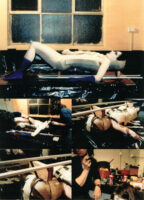
Eliza Hutchison, Memphis Minx, 1998, part 4 of 4, inkjet print
How do ideas relating to 'The Truth’ factor into your practice?
The idea of documentation and the idea of truth really started to evolve from my work The Entertainers. The mechanisms of production I used in this series were hidden and carefully constructed as an experiment into the nature of photographic pose. The images have such an awkwardness to them, and essentially are documentation of the subject dealing with external and unseen constraints. The images were presented as standard photographic portraiture yet, as a viewer one could sense something was not right. A pose complicated by its chain of command, emblematic of another truth in documentation.
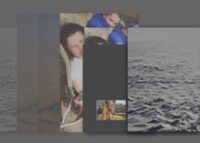
Eliza Hutchison, The difference between the eternal and infinite, 2019, Courtesy of Art Gallery of New South Wales
In this post-internet age, how do you see the viewer in relation to your artwork?
My interests in exploring the aesthetics of everyday has expanded in relation to interfaces we habitat. My work of late has become simulation of a screen share arrangement, the work has arrested diaristic moments of my thought processes—strung together from the series of texts between myself and my close family and friends. So while the aesthetics of the age have really impacted my practice of making work, critical to a viewer’s experience of work for me is their ability to be experienced as its designed to be seen in the size and materiality.
How do you go about developing / planning for new projects?
I often start with an idea and image that interests me and build up a series of thoughts and images and then try to make sense of what fascinates me about them. I start with a premise and a rough approach and build up series of images, much of which is often disposed of in the process but informs the way I think about the project.
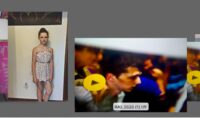
Eliza Hutchison, The difference between the eternal and infinite, 2019, Courtesy of Art Gallery of New South Wales
How does your lived experience influence your work?
More and more, my work over the last 8 years has really reflected the process of making work. I wanted to make work that is intrinsically meaningful to me hence I think the underlying biographic element came to fore even though it was clearly there in previous works.
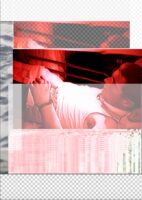
Eliza Hutchison, The difference between the eternal and infinite, 2019, Courtesy of Art Gallery of New South Wales
Who or what inspires you?
So diverse.. I guess anything that appeals to my sense of expanding languages of aesthetics. I love looking at contemporary Japanese architecture at the moment. It’s like some amazing genetic imprint of a cultural design sensibility consistently passed down through generations. Examples I’m thinking are The Deformed Roof House of Furano by Yoshichika Takagi + associates, and House in Nanto, Kazuto by Nishi Architects.
What books are you currently reading?
The Magic Mountain by Thomas Mann.
What is your favourite website / social media account?
#bowdownPodcast
What music are you listening to?
I am really drawn to country music in our present context. There is a documentary series being aired on SBS at the moment called precisely that, Country Music directed by Ken Burns. I am fascinated by the impact of the artist’s upbringing, their social and familial contexts on their person, their careers and their music.
If the work you are presenting at PHOTO was a song, what would it be?
I Walk The Line by Johnny Cash
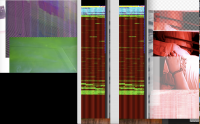
Eliza Hutchison, The difference between the eternal and infinite, 2019, Courtesy of Art Gallery of New South Wales
How are you spending your time with the current social distancing restrictions?
Difficult, between houses, 2 disgruntled teenagers in a tiny house, a sad whippet, a horse to be cared for, a husband trying to work, a studio 100 km away, and a cracked rib. There’s never a good time for this ever to happen, and it’s a precarious balance of the day to day domestic issues in relation to the unfolding tragedy in the world. Uncannily, but not surprisingly, in the present situation the impacts of the world’s political and economic system on our person and our daily lives are more heightened and the very essence of the human condition – our survival – is set in relation to the systems we have created.
How do you hope our creative community will overcome this unique challenge?
I think there has to be hope and followed by persistence in adversity. Bowdown podcast has so many amazing narratives of creative endeavours in less than ideal circumstances.
In this time of Covid 19 I think the way we are in the world must be in for radical rethink. I am curious to see how the sentiment of the times unfolds in my work.
Do you have any daily rituals or unique customs? And if so, why do you perform these rituals?
Taking my daughter to see her horse. A strange and vicarious pleasure as I don’t ride as such, but love the interaction with horses and their care. It’s also an opportunity to be outside in nature, self-distancing.
Do you have any unrealised projects you would like to work on?
I guess the boundaries have always been shifting with the way I have made work but of late the idea of the narrative construction in photography and the concept of the photo poem has really stayed with me.
While my work continues to explore the material understanding of photography as an image capture process, I want further explore the idea of narrative constructions be it through relational aesthetics of the images and or the inclusion of text.
In essence my work is the same project with slightly different parameters, essentially an examination of the human condition as a series of poetic, fractured thoughts.
What advice would you give to your 15 year old self?
Don’t suppress your instincts.
Eliza Hutchison was born in Johannesburg and currently lives and works in Melbourne. All images courtesy the artist and Murray White Room.